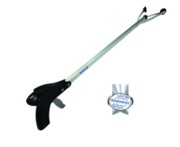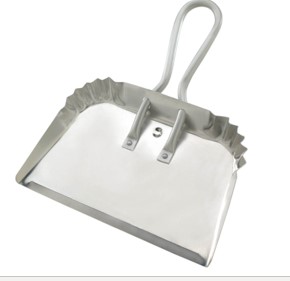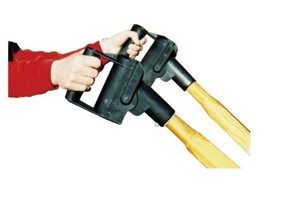
by Stan Logan | Mar 19, 2020 | Garden tools, Irrigation
Kill any plants lately? If so, it was probably because of too little or too much water. The tool you need is the moisture meter. Now, one of the guest speakers (the “Giggling Gardener”, I believe) on the Farmer Fred radio show said that each of us has a moisture meter on each hand. But, honestly, I don’t like jamming my finger down into the soil. I hate dirt under my fingernails. Then too, sometimes even a long finger can’t get through the plant to reach the soil.
Many moisture meters come with 2 probes. I personally find the additional metering of pH and light useless. A second probe also makes it twice as hard to penetrate the soil. Moisture meters are available at garden centers and nurseries for about $10. If you can only find 2 probe models, I suggest you snip off the second probe. Are you really ever going to adjust the pH of your soil? Dip each probe separately into water to see which one detects moisture. Don’t leave the meter in soil between uses. Corrosion will reduce effectiveness. If corrosion appears, use steel wool or fine sandpaper to clean the probe.
I believe most of you have potted plants, and it is those plants that are susceptible to over or under watering. Whether it is potted irises, violets, cyclamen, ferns, or Chinese evergreens, soil moisture needs to be monitored. By the way, you do realize the proper way to water a potted plant is to apply water until it runs out the bottom. That will reduce the buildup of minerals in the soil. Another tip is to beware of drip basins. Water left in a drip basin will cause soil to remain saturated resulting in root rot because of a lack of oxygen.
Keeping potting soil moist can also result in the culture of soil or fungus gnats. These are tiny (like 1/8 in) flies that arise from the soil of indoor potted plants when watered or otherwise disturbed. The flying adults are harmless, but it is the larval stage that can do damage by eating the roots hairs of your plants. Here you can use your moisture meter to monitor soil moisture. Allow the top layer of the potting mix to dry out between watering. This will simply break the life cycle of this pest without the application of various chemical products that are available. Watering from the bottom up is another technique to keep the soil surface dry.
Moisture meters are common in nurseries and can be purchased on Amazon for less than $10. I encourage you to leave the moisture meter somewhere in the house where you will come across it frequently to remind you to check your potted plants. Believe me, you will kill fewer plants by using this simple device.
Keeping my fingers clean,
Stan, The Tool Man


by Stan Logan | Mar 19, 2020 | Garden tools
Now for a tool designed for the older set: the grabber. The grabber, as the name implies, is used to grab things. These tools would occasionally appear at garage sales. Having none, and being The Tool Man, I started collecting several. These grabbers were of different designs, most of which demonstrated why they ended up in garage sales.
The first purpose I found for the grabber was to enable me to pick up things while recovering from hernia surgeries. This was especially needed to pick up the morning newspaper. Later I used the grabber to retrieve the newspaper from beneath our car in the driveway. It’s most common use is to pick up tangerines that are dropping daily. The ability to reach around trees without stepping around so much reduces the amount of soil compaction. Speaking of picking up dropped fruit—have you ever tried to pick up a rotten plum and found that your fingers penetrated the skin so all you end up with is goo all over? This is where a grabber with suction cup ends comes in handy. It’s surprising how the suction cups will enclose the softest of fruit so it can be gently lifted to a waste container. That is why I am recommending this type of grabber. I always thought this suction cup style looked cheap and toy-like, but the suction cups are substantial and versatile in picking up a variety of objects.
Not convinced you need this tool? Do you have a magnolia tree in your neighborhood that sends indestructible leaves into your front yard whenever the wind blows? How about a pine tree that drops cones throughout the year? Got snails? Did your golf ball happen to find the depths of a dastardly water hazard? Ever prune your roses and lose a severed branch down into the plant? How do you pick up a maggot infested carcass in your yard that you discovered a little too late? Did you ever want to tidy up an ornamental bush that had dead leaves or blossoms trapped inside? Do you have grandkids that think it’s fun to use a device to pick up a bedroom strewn with toys and discarded clothes? Ever had a need to retrieve objects from behind or beneath furniture? Do dogs take a dump in your front yard and you find the desiccated remains days later? Have an old-style light bulb in the ceiling that needs changing? (Maybe you should have 2 grabbers—one for inside and one for outside.)
All right, if you still are spry enough to get down on your hands and knees, you may not be ready for this tool. But if you’re like I am, and you don’t mind looking like that old guy down the street who used a grabber to pick up magnolia leaves off his lawn each day, then swallow your pride and buy a grabber. There are many available on line. The one shown is the VIVE Suction Cup Reacher Grabber – 32” Long Heavy Duty Mobility Aid for $19 with Amazon Prime.
Remember, don’t get old and crabby—just be grabby.
Stan, The Tool Man

Grabber

by Stan Logan | Mar 19, 2020 | Garden tools
Getting rid of the leaves that are dropped from deciduous trees in the Fall can be an arduous task. You can use a leaf blower and rakes of various types to form piles. Transporting these piles to a compost bin or to the street for city pick up is generally fairly easy by using a wheelbarrow, utility cart, or simply a plastic garbage can. How do you get the leaves from pile to hauling container? Many of you probably use a pitch fork or snow shovel and these are fine if you have a large task. But for most of you, I have a better choice. This is a dust pan—a large dust pan. This 14” wide pan has a looped handle that gives you good leverage. Don’t buy a 16” heavy metal pan–it’s simply unnecessarily heavy and too large. Use this aluminum pan in conjunction with your rake. Slide your pan under the leaf pile with one hand. Position your rake handle in the crook of your neck and slide your other hand down the handle to the place where the rake tines attach. Raise the handle of the pan and pull the pan and rake together to trap a huge mass of leaves. Then lift the trapped debris to your transport container. When you move from leaf pile to leaf pile, simply toss the pan into your transport container, which is much easier than carrying a large tool like a shovel or fork.
There you have it—a small, light weight tool that makes garden clean up much easier. It can even be left out in the weather since it’s made of aluminum. The Quickie-Professional Metal Handheld Dustpan can be purchased at Lowes for $11.97. This tool would be the perfect Xmas gift, or I suppose you can save this surprise for a future birthday or anniversary gift. You could even write a romantic message in the pan so that your loved one would think of you whenever he or she cleans up the yard trash.
Have fun in the garden,
Stan, The Tool Man

dustpan

by Stan Logan | Mar 19, 2020 | Garden tools
Here is an innovation designed for the gardener who moves so much material that a wheelbarrow is required. You (the heavy duty gardener} have undoubtedly been faced with the awkward task of dumping your load (so to speak). You reach the desired dump location, raise the handles, but nothing spills out. You have to raise the handles to a vertical position, but your hands are on top of the handles when you lift. You have two choices–either lift with such force that the wheelbarrow flips forward, or allow the handle ends to pivot in the palms of your hands so that you are gripping the handles from beneath. The first method is sometimes exciting when the wheelbarrow either drags you over on top of it, or it flips back at you. The second method is scary because it can result in slivers in the palms of your hands if the wheelbarrow has been out in the weather for the last seventy years. (My wheelbarrow was old when my dad gave it to me.)
The solution to the problem, my hard working friend, is Pivoting Wheelbarrow Handles. These are handles that fit over the ends of your wheelbarrow handles. Since they pivot, you have control when lifting from above and as well as shoving from beneath when the handles move through a vertical position. You cannot believe the difference it makes in controlling your wheelbarrow through the entire dumping process.
“But I don’t own a wheelbarrow.” you say. Well, if you have grandkids or pets, imagine the fun you will have wheeling them around the yard and even the neighborhood. And then when you get tired, it is so easy to dump them in an appropriate spot like the swimming pool. I’m not going to suggest a particular wheelbarrow. I think you need to select it on the basis of the occupants.
I will, however, help you with the purchase of your pivoting wheelbarrow handles. Simply Dump it Wheelbarrow Handles SDI1001 can be purchased from Amazon for $18. Is that simple, or what?
Happy dumping!
Stan, The Tool Man
P.S. Actually, since I wrote about these handles years ago, they have come out with wheelbarrows with looped handles that deal with this dumping dilemma. So if you are going to buy a new wheelbarrow, this would be a good option.

by Stan Logan | Mar 19, 2020 | Garden tools
Now here’s a must tool for the iris lover. Irises have to be dug up or at least thinned about every three years. Crowded irises have few blooms. A spading fork is the preferred tool for this chore. It will lift the plant and leave much of the soil behind. I have found that there is an advantage to having a fork with only 2 tines. I can more easily maneuver between adjacent plants when just removing outer rhizomes. But the main advantage to having only 2 tines is that it is twice as easy to penetrate the soil. By cutting off the outside tines and leaving the horizontal bar that connected them, you still have a bar upon which to shove with your foot.
So how can I get a two tiner, you ask. Simply give me a call or e-mail. I will modify a fork you already have, or see if I can get one at a garage sale for you. If you have an angle grinder with a cutting disc, have at it yourself. Remember to remove sharp edges.
None of this appeal to you? Fine. Keep using that favorite shovel or fork that you’ve used for years. Often change is an uncomfortable experience. I understand.
Stan, The Tool Man





